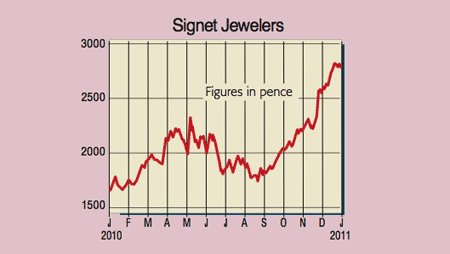
Record bullion prices – gold hit $1,431 an ounce on 7 December – have upended the economics of the jewellery trade. American purchases of trinkets have fallen 36% by volume in just three years. That’s due to gold becoming unaffordable. Women in India, for example, where demand is booming, are buying hollow bangles, according to Bloomberg.
So where does this leave Signet? On the plus side, the retailer is the world’s largest jeweller, operating a total of 1,886 sites in the US (78% of sales) and the UK (22%) under brands Kay, Jared, H Samuel, and Ernest Jones. Sales have sparkled this Christmas, notably in America, and its shops have avoided heavy discounting to clear unwanted inventory.
Better still, this seasonal rally has pushed up prices, in turn boosting gross margins. That translates into forecasts of revenues and underlying EPS of $3.4bn and $2.50 (or £1.60) for the 12 months ending January 2011.
Signet Jewelers (LSE: SIG), rated a BUY by Investec
However, regardless of any short-term sales boost, investors need to be aware that fancy necklaces are one of the most discretionary of consumer items. If there is another wobble in the economy, perhaps caused by a period of stagflation, then Signet’s fortunes will take a dive.
Concerning the valuation, the shares have rocketed over the past two years, and now trade on a 2010 p/e ratio of 17.3. That is way too rich. After all, Tesco, one of the best stores in the world, is only trading on a multiple of 13.5 times. Given all this, I would rate Signet on a through-cycle EBITA multiple of eight. After adding back the net cash of $148m, that delivers a fair value for the stock of around £21 a share.
Going forward, I believe the jeweller will find things much harder. Trying to offload increasingly dear items onto a more discerning, cash-strapped consumer will not be easy. The next trading statement is due out on 11 January.
Finally, gold bugs should note that the sharp decline in gold consumption by the jewellery trade raises an important question. With this traditional backbone of the market in decline, if the current speculative demand were to unwind the price could plummet, perhaps to below $900 per ounce.
Recommendation: SELL at £28.00